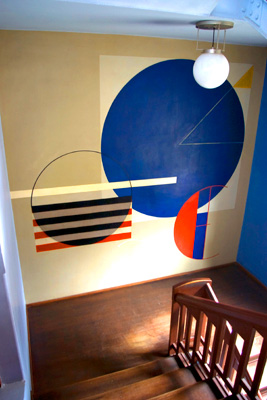Bauhaus building, Dessau. July 2009.
The British gallery-goer, having been treated to several exhibitions in recent years dealing with Bauhaus luminaries and Bauhaus modernism (Moholy-Nagy, Josef Albers, Kandinsky at Tate Modern, the V&A’s Modernism exhibition), might be forgiven for questioning the value in travelling to see the new Bauhaus : A Conceptual Model exhibition at the Martin-Gropius-Bau in Berlin.
The exhibition celebrates the ninetieth anniversary of the opening of the Bauhaus design school in Weimar, and claims to be the largest showcase of the Bauhaus to date. It brings together over 900 objects, distributed through eighteen rooms, that trace the history of the school from Weimar, through to Dessau, and its final demise in Berlin in 1933.
The Berlin exhibition has avoided privileging the most renowned Bauhaus masters, affording plenty of space to lesser-known figures at the school, and of course its students. For example, a speculator model of Johannes Itten’s Turm des Feuers (Tower of Fire)—a cross between Tatlin’s Monument to the Third International and Bruno Taut’s crystalline architecture—stands out in the first room, alongside more familiar skyscraper designs by Mies van der Rohe and Gropius’s Faguswerk factory building.

The evolving theoretical principles that underlined the Bauhaus approach to design, emerge clearly in the thematic treatment of each room, as well as in the transition from one room to another. For example, room two (entitled Impulses from Art) offers a wide variety of painted works and sculptures by Bauhaus tutors, demonstrating their preoccupation with formal experimentation. Following immediately on in the next room (A new Education), is a range of student work produced during the Bauhaus preliminary year of study, which clearly underlines the close working relationship enjoyed between students and their tutors in their explorations of form, colour, line and material.
Some of the rooms work better than others. The Documents and Experiments room, which focuses on photography at the Bauhaus, strikingly contrasts the differences between the informal photographic experiments carried out throughout the life of the school by the likes of Moholy-Nagy and Otto Umbehr, with the austere, Neue Sachlichkeit style of photography produced under tutor Walter Peterhans, in the first of the formal photographic workshops at the school in 1929. By contrast the room entitled, Expanding the Spectrum, displays a range of student work produced in Klee and Kandinsky’s painting classes from 1926, and offers up a mixed bag of works, breaking the hitherto logical progression of the exhibition and adding little to the exhibition’s overall narrative.
Moholy-Nagy’s Light-Space-Modulator is also featured in the exhibition. But while the curators of the Moholy-Nagy and Josef Albers review at Tate Modern in 2006 chose to reproduce faithfully the Modulator’s monochromatic light and shadow effects, the curators in the Berlin exhibition have enclosed the Modulator in a box-shaped room with semi-translucent walls, upon which fall an array of shadows of soft blue, pink and yellow hues. The effect is impressive as the Modulator rotates—it is just a shame it only does so for two minutes in every quarter of an hour.
In the final two rooms of the exhibition dealing with Mies van der Rohe’s directorship, the mood dramatically changes. The light and airy feel of the previous displays give way to blacked-out rooms, metallic surfaces, and mirror-lined walls. Ironically, this curatorial attempt to reflect Mies’ austere, functionalist approach backfires as the information panels becomes practically illegible with their reflective surfaces. The sombre setting is retained in the last room, which documents the final year of the Bauhaus in Berlin. One particularly poignant photograph shows a Nazi flag hanging from one of the windows of Gropius’s Dessau school building.
The only figures who can be said to dominate the exhibition are the three Bauhaus directors—Walter Gropuis, Hannes Meyer and Ludwig Mies van der Rohe—each of whom had in their own mind a vision of which direction the Bauhaus should take. But it is their ideas—reflected in the thematic shifts that occur throughout the exhibition’s displays—which prevail over their individual projects. As one moves throughout the exhibition rooms, the growing preoccupation with functionality, rationality and repetition, slowly begins to emerge in the objects on display. Expressionistic experiments with shape, colour and form give way to simplified Neue Sachlichkeit architectural detail and a new sense of austerity.
If there was one major criticism to be made, it would be that the underlying social and economic circumstances that guided the Bauhaus’s evolving principles are not emphasised enough. However, the sheer variety of work on display is unlikely to disappoint those who decide to make the trip to Berlin.
A well-illustrated catalogue accompanies the exhibition, available in both German and English. The exhibition is due to travel to the Museum of Modern Art, New York in Autumn 2009.
Mark Hobbs. August 2009.
